by Heather Kent | Apr 13, 2015
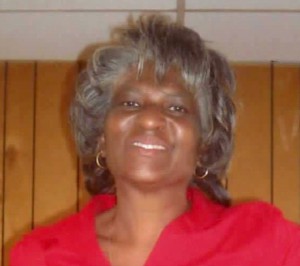
Mrs. Ruth Ann Scurry has been a volunteer for the Jefferson County Hickory Hill 4-H Club for 20 years.
What keeps a volunteer motivated to serve for more than 20 years? If you ask Mrs. Ruth Ann Scurry, a Jefferson County 4-H club leader, she will tell you it’s about making a difference in a young person’s life! Mrs. Scurry raised three sons who were active 4-H members. Her son Kenya even competed at the state level with his demonstration on small engines. Her sons benefited so much from the 4-H program that when her youngest son graduated, she decided to start a 4-H club at her local church called the Hickory Hill 4-H Club. Twenty years later, she still leads this club which focuses on healthy living programs, as well as sewing, gardening, fishing, and consumer choices.
When asked what advice Mrs. Scurry has for club leaders, she shared, “you have to remember to keep the lessons you teach practical and hands on. When teaching nutrition, I show them what a portion size is and remind them to each like a king (breakfast), queen (lunch), and pauper (dinner). If you use examples and language they understand, they will remember. You also have to keep it fun. I make sure to plan a fun treat every now and then to keep the kids motivated and surprised and it works every time. They never want to miss a meeting!”
When asked what is most challenging about being a volunteer today, Mrs. Scurry says, “Many young people today live with only one parent, grandparent, or other relative. These families need help raising their children. 4-H encourages them to make good choices and helps them feel like they belong to an extended family- a 4-H family. 4-H helps them learn how to follow rules and to respect others. Being a good role model is important too. It’s so true that ‘it takes a village to raise a child.’”
Mrs. Scurry has helped build a “4-H village” of caring adult volunteers for her club. She offers simple yet sage advice on how to do this: “Get everyone involved.” She involves everyone from 5-years olds to 83 years old as members and volunteers in her club. She empowers them to make a difference in the lives of 4-H youth by finding out what their strength is, and then asking them to share that strength with the club through an activity, field trip, demonstration, or project.
Mrs. Scurry has not limited her service to just her club. She has also volunteered as a chaperone for 4-H Camp Cherry Lake, the North Florida Fair, and even spearheaded a volunteer appreciation luncheon for local volunteers and community leaders.
Mr. John Lilly, the Jefferson County Extension Director stated, “All of Ms. Scurry’s hard work and dedication affects the entire Jefferson County 4-H Program in a positive way. We are fortunate to have such a loyal and faithful volunteer leader.”
In honor of National Volunteer Appreciation Week, 4-H in the Panhandle is sharing stories of inspirational 4-H volunteers every day this week. if you find Mrs. Scurry’s story inspiring, consider becoming a volunteer yourself! Nearly 3,000 volunteers in the Florida panhandle are making a difference in the lives of more than 28,000 youth. In 4-H, you can leverage your experience and skills to help a young person find their own passions and interests. 4-H needs volunteers like you to inspire the next generation. To learn how to become a 4-H volunteer, contact your local Extension Office or visit http://florida4h.org/volunteers.
Your opinion matters to us! Please take this short survey to help make our blog better. https://ufl.qualtrics.com/SE/?SID=SV_3gtLKjqia3F75QN
by pmdavis | Apr 8, 2015
Most people think of the color green when they think of 4-H, but on April 10th, 4-H youth and volunteers in Florida will be sporting the color purple to show support for our military families. When we think of honoring our military, we often think of Memorial Day and Veterans Day. Did you know there is also a time identified to honor military children? Since 1986, April has been designated Month of the Military Child. This allows us to honor military children for their commitment and sacrifice. Here in the Florida Panhandle we have over 27,800 military youth who deal with situations like having their parents in harm’s way when they deploy.
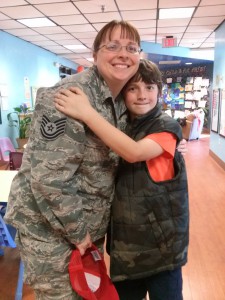
Imagine if someone close to you were deployed. Would you like to see all the news reports showing bombs exploding and people shooting at each other? How would you feel about having long and repeated separations when your parent misses important events like birthdays, holidays, school and sporting events? Would you like it if your family had frequent relocations/moves? Every time families move, children have to make new friends, get used to new schools, and find new 4-H clubs and teams to join.
A lot of military children take these changes in stride and some even thrive on them, but it is hard also – kids have to rebuild their world every time they move. UF/IFAS Extension and 4-H are proud to be a part of the military family working with youth centers across the nation to have some consistency for youth in these situations and who are making these moves. Here locally we want you to join us in showing your support.
So what can you do to show them that we appreciate their sacrifices?
1. Participate in the 4th annual Purple Up! For Military Kids. Wear purple on Friday, April 10th, as a visible way to show support and thank military children for their strength and sacrifices. Why purple? Purple is the color that symbolizes all branches of the military, as it is the combination of Army green, Coast Guard blue, Air Force blue, Marine red and Navy blue.
2. Ask others to Purple Up! We hope everyone will take this opportunity to appreciate and celebrate these young heroes and to thank military families for their support and the freedoms they provide us by their service and sacrifices. Here are a few ideas:
- Ask your local, regional, state, and federal officials to wear purple on April 10th

- Engage fraternal organizations, social clubs, and Rotary groups
- Request local businesses to post a Purple Up! message on their roadside signs
- Ask stores and restaurants to put a Purple Up! flyer in their business window
- Suggest companies and businesses ask their employees to wear purple
- Invite coworkers, as well as members of your spiritual community, exercise class, or golf league to join you in showing support for the military youth in your town by wearing purple on April 10th.
For more information, contact Paula Davis, Ed.D. at the Bay County Extension Office at 850-784-6105. All programs are open to all persons regardless of race, color, age, sex, handicap or national origin.
by pmdavis | Apr 3, 2015
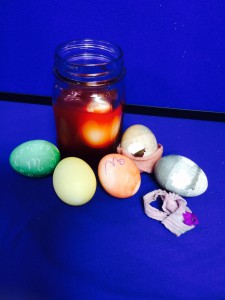
Dying eggs with natural materials is a fun 4-H club activity that teaches a little science too!
This time of year, many children are egg-cited to dye Easter Eggs! This year, instead of buying a kit to dye eggs, why not use natural materials that you most likely already have in your kitchen or yard? One 4-H Junior Master Gardener Project teaches young gardeners how to make dyes made from plant parts and other natural materials and teach a little science at the same time.
Start by cleaning the eggs by wiping them with vinegar. Why vinegar? Well there is a little science behind that…and a great teachable moment! The shell is protected by a thin layer of protein molecules called the cuticle. This cuticle has a neutral charge so not much is attracted to it. The vinegar contains acetic acid, which reacts to make the cuticle positively charged. The dye typically has a negative charge. So to get the dye to “stick” to the egg, the positive charge on the cuticle attracts the negative charge of the dye. (Use a magnet as a visual example.) Therefore the acid is needed to make the color adhere to the shell. FYI! If the egg is left in the acid it will make the shell disappear. (A great experiment for another day)
Back to dyes…Talk to youth about how early Americans made their own dyes. Look around your house to see what might make a good dye and predict what color it will make setting up your own mini science experiment. To make your dyes mix 1-4 cups of plant material or 2 to 4 tablespoons of ground herbs or spices with 1-2 quarts of water in a pot. Bring the mixture to a boil, turn off and steep until cool. Strain, keep liquid and discard plant materials. Juices can be used as is. Soak eggs in the liquid/juice dyes + 1 teaspoon of vinegar – the longer soaked the brighter. If soaking eggs for extended periods, store eggs with dye in the refrigerator. Easter eggs are safe if handled properly. They must not be out of the refrigerator for more than 2 hours.
Ideas for dyes:
- Blue to Purple– grape juice, red grapes, blueberries, red cabbage, blackberries
- Reddish Pink Purple– paprika, red onion skins; beets/beet juice, Cranberries, Hibiscus Flowers, Red teas (Passion, Hibiscus)
- Brown– coffee, black tea
- Golden Orange– yellow onion skins
- Orange– turmeric, ground cumin, yellow onionskins plus beet juice, paprika Green– spinach, kale, parsley, carrot tops.
- Yellow– curry powder, orange and lemon peels, Safflower Petals
For cool effects before cooking/dyeing:
- Draw on your egg with crayons
- Wrap your egg with rubber bands or yarn for a tie-dyed effect
- For a marbled effect, put 1 Tbsp oil in the dye before dropping your egg in
- Stamp your eggs with nature images by placing a leaf or flower on your egg, then wrapping it tightly with a piece of nylon stocking. Dip into dye. When you remove your egg from the dye, carefully remove wrappings.
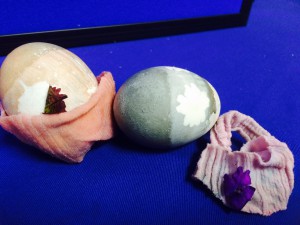
Use leaves or flowers to make interesting prints on your eggs.
Cool effects after cooking/dyeing:
- Sprinkle with salt while still wet and see what pattern emerges!
- For a mottled egg, rub/pat it with paper towel as soon as you remove it from the dye
- Draw with markers when your egg is dry
- To make your eggs gleam, rub vegetable oil on egg after cooled and dried.
These and other activities are part of 4-H, one of the nation’s most diverse organizations. 4-H includes people from all economic, racial, social, political, and geographic categories. There are no barriers to participation by any young person. Participants are given the opportunity to engage in activities that hold their personal interest, while being guided by caring and trained adult volunteers. For more information about joining 4-H as a youth or volunteer, contact your local UF/IFAS Extension Office or visit http://florida4h.org.
by pmdavis | Mar 27, 2015
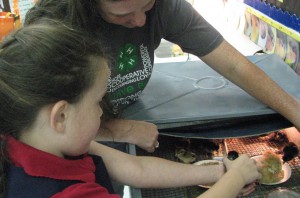 It’s almost Easter when lots of people think about those cute little chicks. Before you take on one of those cute little animals– let’s talk about the responsibilities and considerations when raising chickens
It’s almost Easter when lots of people think about those cute little chicks. Before you take on one of those cute little animals– let’s talk about the responsibilities and considerations when raising chickens
Keeping chickens isn’t much different than keeping pets – they need to be fed and watered every day and, yes, you have to deal with poop. However, most local veterinarians won’t check chickens, so you’ll also need to monitor your birds to know if a health intervention is needed. Handling and socializing your chickens from an early age makes it easier to get them to cooperate, but it also makes it more fun for you to enjoy their antics and unique personalities. If you’re thinking about getting chickens, the first thing to ask yourself is “why?” For human food production, self-sufficiency, selling eggs, entertainment, education for kids or simply as pets? Owning chickens can be all of these 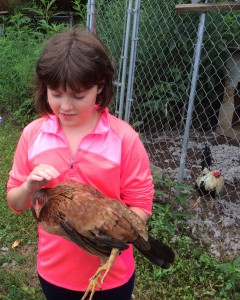 things. Your “why” will help you determine how much you want to invest, as well as guide you to what kind of chickens and coop you will need.
things. Your “why” will help you determine how much you want to invest, as well as guide you to what kind of chickens and coop you will need.
Everything from a few backyard chickens to 4-H projects and farms with several hundred chickens can be considered “small”. Just because a flock is small, does not mean that stewardship, efficient production, safe handling, and other rules can be ignored. Keeping a small flock of chickens for home use, a practice commonplace during our grandparents’ time, is becoming popular again. If you are considering this, you will need to educate yourself about poultry feeding, health and egg production, as well as food safety. There are many University publications on the web.
The University of Florida’s Institute of Food and Agricultural Sciences Extension has several articles on keeping chickens. UF/IFAS Extension has a section devoted to backyard poultry , Basic Guide for the Backyard Chicken Flock, which includes information about brooding, housing, feeding and nesting needs of birds. Other sites include: Escambia County Backyard Poultry Guide and Urban Farming Chickens 101. Other universities with excellent Extension resources to help with backyard poultry include: Mississippi State; Penn State; Purdue Extension; Colorado State Extension; a University of Minnesota and The University of Illinois Extension lists 33 resources on poultry. Another useful site is Illini PoultryNet.
Taking care of the chicks provides a fun way for kids to develop a sense of responsibility, while teaching them work ethics and healthy eating habits. Other ways your children could participate in 4-H and learn about poultry include: The 4-H & Farm Bureau Ag-in-the Classroom Embryology School Enrichment program offered in many counties. There are other activities that youth can engage in including poultry production, judging of poultry and poultry products, preparing foods using poultry and public presentations to inform others about chickens and poultry. Youth can compete in activities at the county, district, state and national levels. 4-H is one of the nation’s most diverse organizations and includes people from all economic, racial, social, political, and geographic categories. There are no barriers to participation by any young person. Participants are given the opportunity to engage in activities that hold their personal interest, while being guided by adult volunteers. The local 4-H Agent is a youth development professional who provides direction and program leadership as part of the nationwide Cooperative Extension System. For more information, contact your local UF/IFAS Extension Office or check out our web-site.
by Heather Kent | Mar 20, 2015
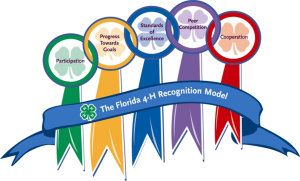
Florida 4-H Recognition Model
Recognition is a basic human need and can help build positive self esteem if handled in the right way and is an important part of the Florida 4-H Program. Whitney Cherry and Karen Miliffe shared tips for club leaders on showing recognition in 4-H clubs during the March Make a Difference Monday session earlier this month. If you missed it, you can view the recorded session at http://florida4h.org/madmondays.
Recognition is more meaningful when it occurs soon after it is earned and is related to a specific task. It can take multiple forms– appropriate recognition varies depending on age, past experience, family lifestyle, community and cultural heritage. Recognition motivates people to excel and take risks and in 4-H, it is the acknowledgement and affirmation of personal growth of an individual or group (such as a club). Awards are simply the things we give people or groups to symbolize our recognition of their accomplishments or effort.
The Florida 4-H Recognition Model includes five types of accomplishments or goals. The five types of accomplishments that 4-H measurers for recognition are:
- Participation in educational experiences (certificates, t-shirts, participation ribbons). The requirements for recognition for participation in a 4-H event are well publicized and easy to achieve. These types of recognition can be earned many times and are usually not expensive, but valued.
- Progress toward self-set goals. It is important for youth to learn to set goals and work towards them. 4-H project books are one way that we provide feedback on self-set goals. The club annual program is a tool for setting the collective goals of the club. As volunteers, we can assist youth with this by reviewing their goals frequently during the 4-H year, identifying what they have accomplished so far and helping them determine their next steps toward a goal.
- Achieving standards of excellence. In 4-H standards are used in two ways:
- Standards are established by subject matter and youth development specialists to provide a basis for young people to plan and work toward their goals
- Professional staff and /or volunteers and young people work together to establish standards– such as dress code at 4-H University, expectations of 4-Hers in club meetings, desired behavior at 4-H events/ camp
- Excelling in peer competition (judging contests, speaking contests, exhibits, animal exhibits and shows, portfolios, project book contests). Competition has long been a component in the 4-H program. 4-H strives to make competition an educational process and an opportunity to teach youth life skills. Peer competition is competing against one another’s peers. Numerous competition exist form the local club level, county, district, state, regional and national. 4-H also provides opportunities for clubs to compete against other clubs with the Club Standards of Excellence and Community Pride programs. Keep in mind that competition is not suitable for all ages (members 5-7 years old) and competition rules and procedures should be clear.
- Excelling in cooperation within a group (team or club awards or media recognition for service projects). From the beginning 4-H has encouraged young people to work together to learn. Cooperation engages young people in group experiences that are interdependent– face-to-face interactions, individual and group responsibility, group skills development. Cooperation involves everyone in the group and uses mutually agreed upon goals.
Recognition is a significant incentive to further learning. When properly used, it inspires young people to belong. Through caring adults and peers, in an inclusive and safe environment, recognition helps meets the needs of young people. Youth become and stay active in 4-H because they benefit. 4-H provides many opportunities for volunteers to make a difference in the lives of young people. If every young person could step into 4-H, imagine all the resourceful problem solvers, skilled workers, and capable leaders they’d become. That future is in our reach if we all lend our time and talents to guide the young people who will create it. Make the investment of a lifetime- become a 4-H volunteer, and inspire the next generation!
by Jena Gilmore | Mar 13, 2015
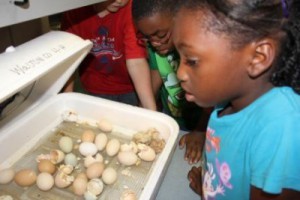 The 4-H embryology project focuses on the science of embryology, which is a branch of biology that deals with the development of an embryo from the fertilization of the ovum to the fetus stage. This 4-H project is often conducted in elementary schools, but can also be done as part of a 4-H club project. 4-H volunteers, or project leaders, help youth set up incubators filled with fertilized eggs and teach them how to maintain adequate conditions for the incubators. While waiting for the eggs to hatch, youth learn the science of how embryos develop. Finally the day they’ve all been waiting for…HATCH DAY! Students and teachers experience a day of melodious chirping, fluffy chicks pecking about, and if they’re lucky they may even see a few hatching in action. While this day is bittersweet, who says the 4-H Embryology Project experience has to end here?
The 4-H embryology project focuses on the science of embryology, which is a branch of biology that deals with the development of an embryo from the fertilization of the ovum to the fetus stage. This 4-H project is often conducted in elementary schools, but can also be done as part of a 4-H club project. 4-H volunteers, or project leaders, help youth set up incubators filled with fertilized eggs and teach them how to maintain adequate conditions for the incubators. While waiting for the eggs to hatch, youth learn the science of how embryos develop. Finally the day they’ve all been waiting for…HATCH DAY! Students and teachers experience a day of melodious chirping, fluffy chicks pecking about, and if they’re lucky they may even see a few hatching in action. While this day is bittersweet, who says the 4-H Embryology Project experience has to end here?
That is the exact question that Walton County 4-Her Justin Bolen asked himself when he got involved in the 4-H embryology project. At age 9, Justin stepped up and expanded his 4-H poultry project into a business. He discovered a demand for free range chicken eggs in his local community and build his business around filling that need. Justin took out a loan with his family to purchase the necessary equipment to start his own business. He learned skills such as feed management, environment maintenance, record keeping, health care for poultry, and effects on hatch rate.
Justin’s passion wasn’t only 4-H and poultry, but also to learn how to maintain a debt free business. He repaid his loan to his
family by age 11 and was producing 100 dozen eggs per month. At age 13, Justin used his “egg money” to purchase his first horse, Brave, for $1500. Just two years later (as his riding skills advanced) Justin sold Brave and used that money along with more “egg money” to purchase a Lambert Morgan Horse, named Trey, for $4,200. In January 2014, Justin was the first 16 year old to be approved to participate in Chris Cox’s Colt Starting Clinic, for which he again paid tuition of $1,400 with his “egg money.”
Today, at age 17, Justin currently has 22 customers with a whopping 47 dozen eggs per delivery every other week. In order to give back to 4-H, Justin has agreed to provide the Walton County 4-H Embryology Project with fertilized eggs to support the program throughout the county so that other youth can not only learn about the science of embryology, but the business opportunities as well! Justin’s success story is proof that with “EGG-ceptional” dedication and determination, other youth can have the same experience he did in 4-H and become an entrepreneur themselves!
As a 4-H volunteer, you can share your personal interests and expertise in a variety of subjects including gardening, shooting sports, robotics, animal science, sewing/crafting, public speaking, foods and nutrition, and much more. In 4-H, you can leverage your experience and skills to help a young person find their own passions and interests and possibly even ignite a future career! 4-H is an opportunity we wish every young person could have because research shows it is a step forward. More than 60 million of our nation’s most successful statesmen, business leaders, and scientists credit 4-H with setting them on a positive, productive path. When you share your experiences with 4-Hers, you make a difference by helping youth become caring and competent citizens with a desire to contribute to their communities. To find out how to become a 4-H volunteer, contact your local extension office or visit http://florida4h.org/volunteers.
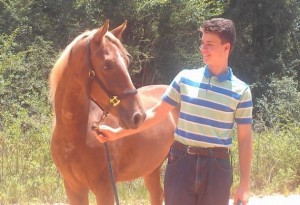
Justin and his horse, Trey.
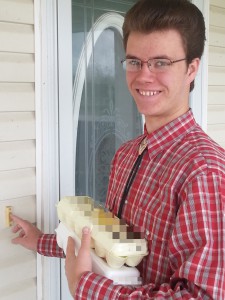
Justin delivering eggs to customers.
This article was written by Jena Brooks, Walton County 4-H Agent brooks15@ufl.edu.
by Heather Kent | Mar 6, 2015
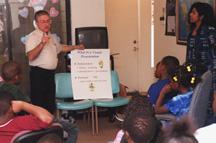 Have you ever attended a meeting for the first time and felt a little out of place? Do you remember that nervous feeling; the pit in your stomach of not knowing anyone, not sure if you belonged? Creating a welcoming environment in 4-H clubs and events helps members and volunteers have a sense of belonging. A sense of belonging is one of the Essential Elements of Positive Youth Development. Last month, Georgene Bender and Jon Mayer shared ideas for creating a welcoming environment in your 4-H club during our February Make a Difference Monday session.
Have you ever attended a meeting for the first time and felt a little out of place? Do you remember that nervous feeling; the pit in your stomach of not knowing anyone, not sure if you belonged? Creating a welcoming environment in 4-H clubs and events helps members and volunteers have a sense of belonging. A sense of belonging is one of the Essential Elements of Positive Youth Development. Last month, Georgene Bender and Jon Mayer shared ideas for creating a welcoming environment in your 4-H club during our February Make a Difference Monday session.
1. Welcome new members– have a welcome committee for your club. This committee can be a group of members or even a 4-H family that is willing to come to the meeting early to welcome any new members. They could even prepare a welcome packet with 4-H enrollment information, club brochure, calendar, 4-H pen or pencil, or even a club t-shirt. You can ask your 4-H agent for some ideas or items to include in the welcome packet. There are many inexpensive “4-H trinkets” for $1.00 or less available at the 4-H Mall. Assigning 4-H families to mentor new 4-H families is also a great way to mentor and orient new members.
- Plan “get acquainted games”- it’s difficult to feel comfortable in a group when you don’t know people well. Leading get acquainted activities during club meetings (especially at the beginning of the club year) will help establish a friendlier club environment. Ice breakers, get acquainted games, or even roll calls that ask questions about member’s interests (answer roll by making the sound of your favorite animal) can help members get to know each other better.
- Encourage engagement– a great way to get new members involved is to use the 4-H Clover worksheet to help plan the club year. If the member joins after the club planning meeting, get them involved in a committee. Smaller committees are less intimidating and can help new members feel like they belong and have something to contribute.
What will you do this year to help make new members feel welcome? Leave us a comment below! To learn more about creating welcoming environments in 4-H clubs, you can view the full, 1-hour workshop online at http://florida4h.org/madmondays.
by Yolanda Goode | Feb 27, 2015

My Heart to Greater Loyalty…
A handwritten note or card can express one’s gratitude, thankfulness, care, or encouragement and has not gone extinct even in this age of technology. Just think about the last time you received a personal handwritten note from someone. You may have gotten emails, texts, or posts relating to the same event and you appreciated it all but isn’t there just something a little extra special about receiving a written note?
Florida 4-H helps youth develop life skills. Life skills are those competencies (measurable or observable knowledge, skills, abilities, and behaviors) that assist people in functioning well in the environments in which they live. Life skills are transferable which makes them different from task specific skills like tying a bow or knot.
In February we think of all things related to the heart due to Valentine’s Day. The second H in 4-H stands for the Heart. Looking at Targeting Life Skills in 4-H, the Heart has two life skills subcategories; caring and relating. The specific life skills under caring are empathy, sharing, nurturing relationships, and concern for others. Youth need an opportunity to demonstrate these skills throughout the year.
This takes us back to the handwritten note and your call to action to cultivate the art of note writing in our youth and give them another outlet of expressing the life skills connected to the second H in 4-H.
Tips to Get Started
- Collection of note cards (Cards could be club themed and can even be hand-made by youth)
- Good writing pens
- Stamps (Unless personally delivering them)
- Keep supplies in your 4-H club box so that you will have them when you need them
According to David Horsager, notes should be specific, personalized, and authentic (S.P.A.) The note does not have to be long. Younger members, such as cloverbuds may just want to draw a picture that expresses thanks or encouragement. If having youth write cards, teach them want should be included in an artful handwritten note:
- What they are thankful for or what they want to encourage or motivate someone about
- How the person has benefited them or how they will use the gift
Even as adults we can demonstrate the life skills under caring. One of my goals this year is to more deliberate and intentional when writing personal notes for work, family, or friends. With practice, this will become easier and having my supplies at work and home will help me get that personalized out and make someone’s day a little brighter and better. What will you do differently this year to model the 2nd “H” in 4-H? Leave us a comment below!
~this article was written by Yolanda Goode, 4-H Agent in Gadsden County
by Heather Kent | Feb 20, 2015
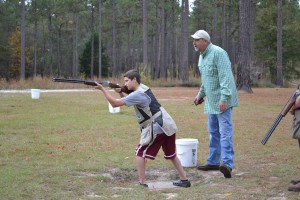
Gary Clark, Sure Shots 4-H Club Leader
In Washington County, the name Gary Clark is synonymous with the 4-H Shooting Sports program. Gary decided to start a club because he wanted to do something that would benefit the next generation of hunters, conservationists, and shooting sports enthusiasts. When asked what he most enjoys about being a 4-H volunteer, he replied “It is a way to give back to a community that has always supported me.’
Gary takes his role as a mentor and role model very seriously. “There are young people watching and listening to your every word, not so much for guidance and inspiration, but to see if you are walking the talk. Working with young people today is not so much about passing along knowledge and teaching life skills as it is about making investments in their lives. Showing the same care and concern for every youth you are working with, no matter what skill level or potential, is critical to that young person viewing themselves as successful.” Relationships with caring adult volunteers is one of the Essential Elements of Positive Youth Development that 4-H is built upon.
I believe that we all have not only an opportunity, but an obligation to help to make our communities a better place to live. I think back on the people who gave their time and resources to coach and mentor me when I was young and I am thankful for the generosity. No amount of time spent investing in the lives our youth is ever wasted!
Seeing kids succeed is what keeps Gary motivated to continue his volunteer service. “Our teams have been extremely successful, but most of that success is measured on the personal level. When you see a student achieve a new personal best or overcome an obstacle that has held them back and you see that little light go off inside their brains, you can’t help but be inspired and so proud of their achievements.” Gary also finds motivation when his 4-H Alumni return to the program as volunteers. “Two former students are also now certified coaches in the program and help out on a regular basis. Seth Pemberton is one of those youth. Seth shares, “Gary has positively impacted my life through 4-H shooting sports by making me strive for excellence, work hard, and give my best.”
Gary shares what inspires him most about being a volunteer is working with youth who would otherwise not have the opportunity to be part of a team. “Unlike so many other sports, shooting is a pretty level playing field- it isn’t only for the most athletic, the smartest, the most popular or the kid that can afford the best equipment. Every member comes into the program with an equal opportunity for success. It is all based on their commitment, focus, and [goals they set for themselves].”
Gary is very modest about his impact his club has on youth, but Julie Dillard, the Washington County Extension Director says, “Gary’s dedication to his community and his 4-H’ers is inspiring and has been the key to the success of Sure Shots 4-H Club. He encourages, praises, corrects and motivates each individual to be his or her best.”
When asked what he feels youth get out of the 4-H Shooting Sports program, he says “They learn about respect for others, commitment, teamwork, goal setting, cooperation and even how to handle disappointment [sportsmanship]. All of these traits come from being part of a program like 4-H. I do not know of any other organization that offers so many different ways for youth to be involved in their community in a structured, safe and nurturing environment that is built on the values and principles that we all hold so dear. I also believe that these skills will follow them throughout their adult lives as well.” Gary’s experience with 4-H is backed by research. The Tufts Study of Positive Youth Development found that compared to other youth, 4-H members are:
- Four times more likely to contribute to their communities
- Two times more likely to be civically active
- Two times more likely to participate in science, engineering, and technology programs during out of school time; and
- Two times more likely to make healthier choices.
Would you consider making the investment of a lifetime by becoming a 4-H volunteer? 4-H offers a variety of volunteer roles based on your interests and schedule. To find out more about being a volunteer, contact your local Extension Office or visit http://florida4h.org.
by Stefanie Prevatt | Feb 13, 2015
I have a love-hate relationship with Pinterest. I am, admittedly, a perfectionist. And Pinterest sets me up for failure. Perhaps it’s because I am the least crafty person you will ever meet, but nothing ever turns out the way it looks in the photos. Yet, I keep searching and trying new things.
Today’s Pinterest find was a neat little project I found here. I was immediately drawn in by the cute little hearts and the idea that no sweets are involved! Upon exploring this project further, I came to believe this had success written all over it: find crayons, chop up crayons, melt. Easy peasy. Turns out, things were a little more complicated than that, but I would still suggest this as a doable project for 4-H’ers of any age (with proper adult supervision, of course).
Crayon Hearts
1. Collect used crayons. Ask members to bring them to your meeting. You want a good mixture or bright and dark colors.
2. Peel paper off crayons. This was by far the most tedious task. If you will be doing this activity with younger 4-H’ers, I would bring the crayons already peeled.
3. Cut crayons into small pieces. Upon completing this, I realized I should have cut mine a little smaller to help with their melting.
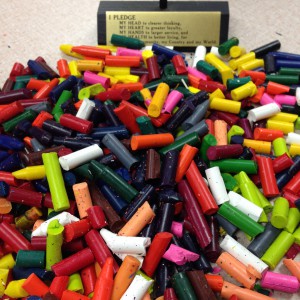
cut crayons
4. Put crayons in silicone baking tray. 230 degrees for 15-20 mins.
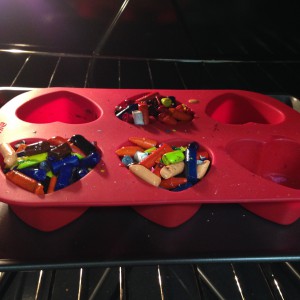
baking crayons
5. Let heart crayons cool and remove (more like peal) from tray.
Now what?
There is so much more to this activity than breaking crayons and melting them into hearts.
- Teamwork is required to prepare all the materials. Don’t forget, crayons won’t peal themselves!
- Planning and organizing are required if youth want to have hearts turn out a certain color. Check out these crayons.
- Decision making is necessary to figure out what will be done with the crayon hearts.
- Should the hearts be donated to a local children’s hospital or Ronald McDonald House?
- Older youth can figure out the per item cost of each heart and compare it to the cost of store-bought gifts.
Whether you need something related to your specific project area or you are seeking an idea for a fun, themed activity, Pinterest will certainly not disappoint. Don’t forget, even if your activity turns into a Pinterest fail, celebrate the teachable moments and successes along the way!
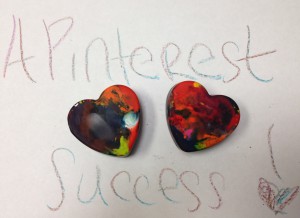
A Pinterest success!
References:
Crayon hearts: https://www.pinterest.com/pin/115334440431430268/
Nifty crayon hearts: https://www.pinterest.com/pin/409898003556943584/

















